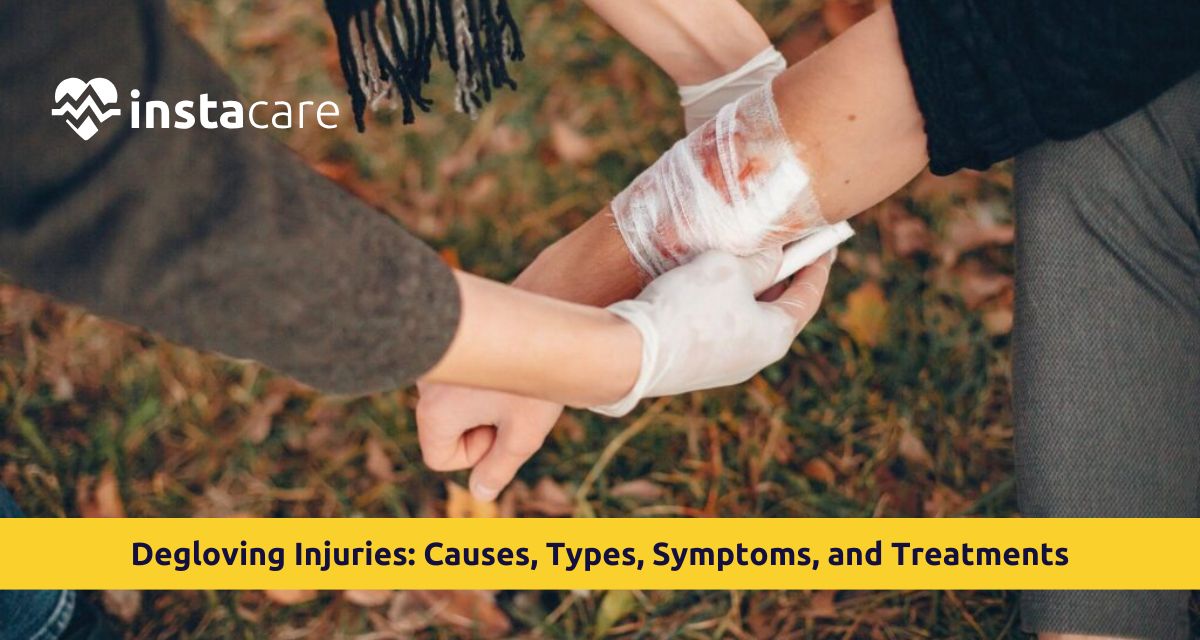A degloving injury represents a serious, complex traumatic wound. Such injuries present themselves rarely yet require fast medical intervention because they trigger severe pain and life-threatening consequences. People who know about degloving injuries and their differing types will better react when such wounds appear.
What is a Degloving Injury?
Degloving refers to the traumatic event that separates outer skin layers and tissue from the subcutaneous muscle tissue alongside bone structures and connective tissue. Degloving injuries resemble the process of removing a glove from the hand hence they carry their name.
The detachment of upper skin layers together with underlying tissue during extreme traumatic events leads to the removal of delicate inner body materials and produces serious medical dangers like
bleeding and infection.
Types of Degloving Injuries
The degree of degloving injuries depends on both the cause of the injury and the specific body area involved. The most common types include:
1. Open Degloving Injury
The most evident degloving injury shows complete separation of skin along with surrounding tissues from the body. The injury primarily affects limbs through the body parts of hands, arms and legs, and feet, resulting from being trapped in machinery and road accidents.
2. Closed Degloving Injury
A degloving injury of this type preserves the skin through the separation that happens beneath the tissue layers. These injuries start as hidden processes because patients initially do not see them, yet the unattended condition ends in fluid accumulation that can develop into infections or tissue death. Hip and buttock, along with thigh regions, are the typical locations for Morel-Lavallée lesions to develop after sustaining high-energy traumatic injuries.
3. Degloving of the Scalp
Such an unusual yet life-threatening injury mostly takes place when hair or headwear touches industrial machine rotators. Significant bleeding, together with major cosmetic disfigurement, results from this type of degloving injury.
4. Degloving of the Face or Genital Area
Such cases remain rare, mostly occurring in extreme road traffic accidents or attacks by animals. Treatment requires special approaches because of both complicated structures and associated psychological effects.
Some Important Symptoms of Degloving
The right treatment requires immediate recognition of degloving injury symptoms. The exhibition of symptoms depends on whether the wound is open or not.
- Severe pain and visible skin detachment in open injuries
- Swelling and bruising
- The presence of bleeding, along with visible muscle damage, fat, and bone elements.
- Dead or pale-looking skin in the affected area
- Fluid accumulation under the skin in closed injuries
- Loss of function or movement in the affected limb
- Extreme pain is often accompanied by nerve-related sensations that produce numbness alongside tingling.
- Foul odour or pus (in case of infection)
View More: What You Must Know About Whiplash Injury? Causes, Symptoms, & Treatments
Various Causes of Degloving
High-energy trauma producing shearing force against the skin leads to degloving injuries. The most common causes include:
1. Road Traffic Accidents
Degloving accidents involving motorcyclists or vehicle run-overs lead to degloving injuries, mostly affecting the legs, arms, and scalp, as well as motorcycle-related drag and vehicle compression on the limbs of victims.
2. Industrial or Workplace Accidents
Loss of body tissue occurs when heavy machinery and conveyor belts and rotating equipment push clothing which then tears the skin when a limb gets caught.
3. Falling from Height
The shearing forces between hard surfaces and objects generate enough strength to detach both skin and its underlying structures.
4. Animal Bites or Attacks
The destructive impact of extreme animal aggression leads to serious damage of both skin layers and underlying tissue in exceptional instances.
5. Sport Injuries
During high-impact forms of sport and contact play there is a possibility for closed degloving injuries to happen in the thigh or hip zones.
Degloving Injury Treatment
Professional intervention for treating degloving injuries demands specific plans based on how severe and where the damage occurred in the body. Acceptable treatment of degloving injuries requires a collaboration of emergency medicine with surgery, as well as orthopaedic medical expertise and physical therapy.
1. Initial Stabilization
- Under medical supervision, patients need either pressure dressings or tourniquets to stop bleeding.
- Immobilize the area
- Medical staff should provide fluids alongside pain medication for patients under hospital care.
- Antibiotic treatment combined with a sterile dressing helps prevent infection.
2. Surgical Intervention
Most degloving trauma injuries require surgery. The surgical repair of the degloving injuries may include:
- Debridement – removal of dead or contaminated tissue
- Medical professionals conduct skin grafting by transferring skin from a different part of the body to seal open areas.
- The procedure of reattachment or flap surgery involves either placing the removed skin back in its original position or using muscle flaps to cover the damaged area.
- Medics perform amputation when patients lose their limbs and doctors cannot salvage them.
3. Wound Care and Infection Control
After surgery, proper degloving wound care remains essential for patient recovery. Wound healing requires regular cleansing methods and adjustments to dressing, alongside active monitoring for infection.
4. Physical Therapy and Rehabilitation
The need for extended treatment to restore body mobility becomes necessary based on the intensity of the injury, as well as the involvement of joints or muscles. This may include:
- Range of motion exercises
- Strength training
- Occupational therapy for limb functionality
5. Psychological Support
Permanent disabilities and disfigurement result from traumatic injuries, so patients need
psychological counselling after this type of experience.
Prevention Tips for Degloving Injury
Several safety measures could lower the probability of sustaining degloving injuries, although some cases cannot be completely prevented.
- All workers must wear protective equipment in industrial areas.
- People should stay away from loose garments and jewelry when machinery is in motion.
- Athletes should protect themselves with helmets and other protective equipment when participating in activities that pose significant risks.
- All drivers must follow road safety protocols, including the use of protective seatbelts and appropriate riding equipment.
- Children under your care should be supervised when they are around animals or machinery.
Prognosis and Recovery
Different variables like injury positioning, along with its intensity and timely medical response, alongside patient well-being, will determine the recovery process for degloving injuries. Medical intervention at the right time makes complete recovery possible for some patients, yet other people will need to live with lifelong physical limitations and disfiguring issues.
Conclusion
Degloving injuries need immediate medical attention and complex care because of their complexity. The knowledge of what causes degloving injuries alongside their symptoms and treatment solutions, helps people respond immediately in emergency situations. Strong medical intervention with proper recovery protocols enables numerous patients to recover their functional abilities while improving their life quality.
Please book an appointment with the
best Plastic Surgeon in Lahore, Karachi, Islamabad, and all major cities of Pakistan through
InstaCare, or call our helpline at 03171777509 to find the verified doctor for your disease.

